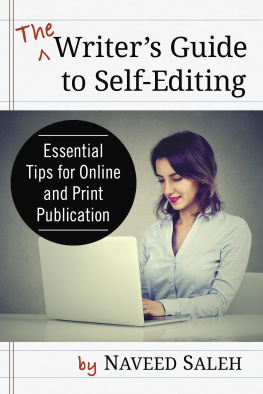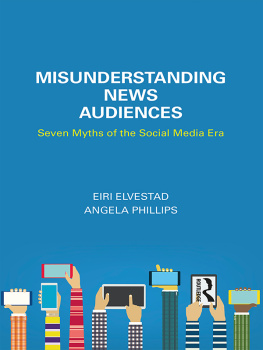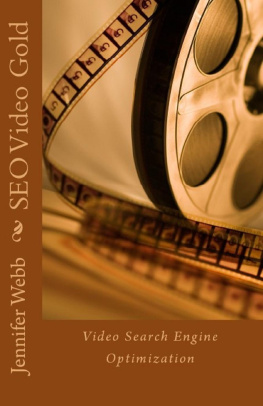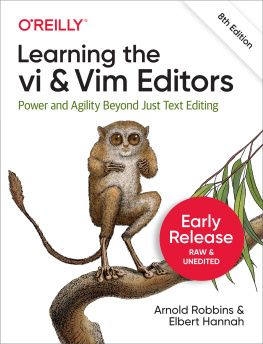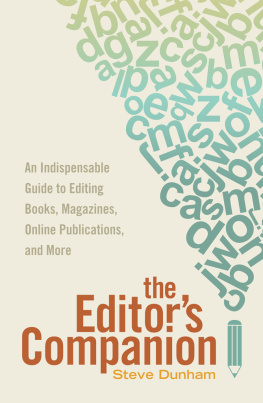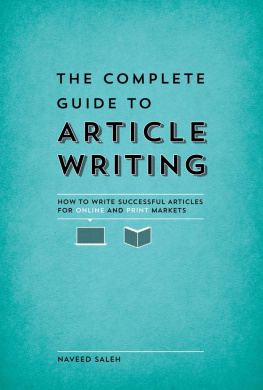
The Writers Guide to Self-Editing
Essential Tips for Online and Print Publication
NAVEED SALEH

McFarland & Company, Inc., Publishers
Jefferson, North Carolina
LIBRARY OF CONGRESS CATALOGUING DATA ARE AVAILABLE
BRITISH LIBRARY CATALOGUING DATA ARE AVAILABLE
e-ISBN: 978-1-4766-3404-3
2019 Naveed Saleh. All rights reserved
No part of this book may be reproduced or transmitted in any form or by any means, electronic or mechanical, including photocopying or recording, or by any information storage and retrieval system, without permission in writing from the publisher.
Front cover photograph by SI Photography/IStock
McFarland & Company, Inc., Publishers
Box 611, Jefferson, North Carolina 28640
www.mcfarlandpub.com
For Maliheh, Saeed, Fareed, Zain, Zaid,
Zachary, Zavier, Dokhi, Emily, Charlie,
Dr. Gastel, Mrs. Robichaud, Dr. Trunsky,
Dr. Balon, Dr. Christensen, Madame Corcos,
and Mrs. Witucki. It takes a village
Preface
We live in marvelous times where the Internet has changed so much so fastmost notably publication.
With the immediacy of online content, media coverage has transformed. We no longer have to wait for the morning newspaper to find out about an event that occurred half a world away. Nowadays, news is instant, and theres a premium for timely copy thats clean and well written.
Sheer volume and rapid turnover limit editorial oversight at even the biggest online publications. Many successful professional writers who routinely attract tens or even hundreds of thousands of readers a month must turn in publishable content without the benefit of a dedicated editor who will provide comprehensive feedback.
The Internet has also provided so many more writers access to publication. Nowadays, anybody can set up a website or WordPress blog and attract a following. These writers are one-person shows who act as their own fact checkers, editors, and publishers. That being said, nothing beats having a knowledgeable and experienced editor review your work. Unfortunately, in the current media milieu, many writers lack this luxury. Instead, writers must become self-editors.
The principles presented in this guide will help you become a successful self-editor who is capable of producing publishable nonfiction autonomously. Moreover, even if you have the benefit of an editor who will analyze your work before publicationsuch as, for example, at a reputable print publicationthe principles contained herein will help you present crisp copy, which will no doubt please.
This book grew out of my own study of style guides and editing treatises representing various publishers and organizations. As a professional writer and editor, I learned to use such style guidance to not only edit articles and other documents for clients but also to benefit my own practice of writing. By self-editing my own work, my writing improved greatly. I hope to share this knowledge and success with others interested in becoming self-editors.
When writing any style, writing, or editing guide, one obvious concern is how to distinguish the new guide from what is already out there. This book is different from other books in two notable ways. First, this book looks at online publishing practices in detailusing the most current knowledge of search engine optimization (SEO) to help guide the writing and self-editing process. Second, this book endeavors to take an evidence-based approach to writing and self-editing. This book extends past the prescriptive guidance of ordinary stylebooks, and it incorporates empirical, corpus-based research from prominent linguists including Geoffrey Leech, Douglas Biber, and Pam Peters.
One limitation of corpus-based research is that closed corpora become dated. Much of the data presented here dates back to corpora from the late twentieth century. Moreover, with the advent of the Google and sophisticated search tools, the field of corpus linguistics will likely soon evolve to include web-based approaches.
Introduction
This book is intended for anybody who wants to create clean copy that is ready for publication. To apply the principles described in this guide, a person need only a curious mind and a critical and introspective eye. Ultimately, I see this self-editing guide proving of value to aspiring and professional writers of nonfiction alike.
I suggest using this book in the following fashion. First, read the book in its entirety. Second, write your own articles and other nonfiction documents with these principles in mind. Third, edit your work using these principles. In sum, I want you to write as best you can and then self-edit using these principles. If done well, after you write and self-edit, you can publish your work: write, self-edit, publish.
After reading this book once through, I hope that it remains a lifelong reference that will aid in all your online and print publication efforts. For ease of reference, this book is divided into seven parts: Style, Diction, Mechanics, Punctuation, Organization, Online Publication and Global Considerations. The part on style provides guidance that is well accepted by many experts and publications. The part on diction, however, goes much deeper to explain how to use words in a clear, correct, and effective manner.
Much of the guidance in this book is intended for every writer at any skill level. Some of the guidance in this book is more nuanced and intended for those who pay close attention to the craft. Often, its small differences that distinguish the work of a professional writer.
Each of the 75 chapters (tips) is structured so that it can stand alone. In order for each tip to stand alone, key concepts are occasionally repeated. Because some points are covered from different vantage points in different parts of this book, I encourage you to use the index to further explore each topic.
If you want to learn more about where I gleaned the information found in this book, please take a closer look at the bibliography. When structured well, a bibliography can serve as a road map that indicates where a writer has been during the writing process.
Part I: Style
1.
Adverb Placement
Tip: In general, place an adverb closest to what it modifies.
Key Points
With transitive verbs, adverbs are placed before the verb.
With intransitive verbs, adverbs are placed after the verb.
In a verb phrase that consists of an auxiliary verb and a principal (main) verb, an adverb that modifies this phrase is naturally placed between the auxiliary verb and the principal verb.
Splitting infinitives is okay.
Watch your placement of only.
Copulative verbs take adjectives, not adverbs.
Generally, you want to place an adverb closest to what it modifies. Doing so limits confusion. You also want to make sure that your use of adverbs is idiomatic and sounds right.
This general guidance, however, belies how nuanced the proper placement of adverbs can be. It also fails to address issues of contention, such as split infinitives and splitting verb phrases.
Unfortunately, many writing and editing texts provide only cursory guidance with regard to adverb placement. Two guides that provide more robust guidance regarding adverb placement are
Next page
